So, you want to build muscle, huh? I was once a skinny hard gainer too. 138 lbs soaking wet and could barely shoulder press the 10 kg dumbbells. But over many years of training, researching, and coaching professional athletes, I have learned and implemented many strategies that can help you build muscle.
Even though I started at 138 lbs in my late teens, I reached 200 lbs by my mid to late twenties. It is possible. And I'm not that tall either (5'8"). Now I'm going to share how to undergo the same transformation for yourself.
It’s not an overnight process. But with consistency and discipline, you will become the beast who needs new shirts and jeans that fit your muscular physique. Let’s start with my eleven best tips for building muscle.
Table of Contents
11 Best Tips To Build Muscle
These are eleven of the best tips to build muscle based on my years of experience lifting weights, studying sports science to a Master’s degree, and my years of coaching experience.
Eat More
The equation is simple. You must consume more calories than you use, and the only way to do this is to eat more. This is where almost everyone falls short with their quest to build muscle mass. But how can you eat more if you’re already stuffed full at breakfast, lunch, and dinner?
For those skinny hard gainer guys (I was one too), these are some easy strategies to increase your calorie count even when you can’t fit any more food in your stomach:
I have used all of these strategies successfully. I started at 63 kg (138 lbs) in my late teenage years and reached 74 kg (163 lbs) in my early twenties. From there, in another few short years, I gained more muscle mass, reaching 84 kg (185 lbs) and eventually to my heaviest bodyweight of 93 kg (205 lbs).
These bodyweight changes were all made through the strategies I listed above. Learning to eat more is essential if gaining muscle is your priority.
Eat More Often

If you’re eating one or two meals a day, you’re not going to build muscle. I wouldn’t say it’s impossible, but you’re making it damn hard on yourself. If you need to eat 3000 calories a day to gain muscle mass, that would be 1500 calories per meal.
I don't know about you, but that’s like performing a YouTube food eating challenge twice a day every day. If you can eat five or even six meals per day, you can break your total calorie count into smaller meals you can actually finish.
Move Less
One common weight loss strategy is to move more, also known as increasing your NEAT (non-exercise activity thermogenesis). Since we want to get huge, you want to do the opposite. Move less. If you don’t need to run, walk. If you don’t need to walk, stand. If you don’t need to stand, sit. If you don’t need to sit, lie down.
The less energy you use outside of lifting weights, the less food you’ll need to consume to exceed your daily maintenance caloric intake.
Get Adequate Protein
While calories are going to dictate whether you gain or lose weight, protein intake will dictate the quality of your weight gain. If your protein is too low, you’re likely to gain more fat than muscle mass.
The general rule of thumb is to consume 1 g of protein per pound (2.2 g per kilogram) of bodyweight per day to build and maintain muscle mass [1].
However, when in a caloric surplus (i.e., eating more calories than you burn), the excess carbohydrates and fats become protein-sparing, so you can reduce your protein intake to 0.8 g of protein per pound (1.6 g per kilogram) of body weight. Handy if you want to lower your meat consumption and grocery bill [2].
Train With More Volume
While strength development is mainly influenced by intensity (i.e., how heavy you lift), building muscle is dictated by effective training volume. As in, there is a dose-response relationship between training volume and muscle growth [3]. Meaning the more volume of lifting, the greater the muscle growth.
But only to a certain point. It seems that upwards of 25+ sets per week per muscle group is the limit for seeing any further gains in muscle growth. That doesn't mean you should program 25 sets per muscle group every week.
You can prioritize certain muscle groups while maintaining others or periodize training cycles where you go from lower to higher volumes.
Lift Isolation Exercises Close To Failure
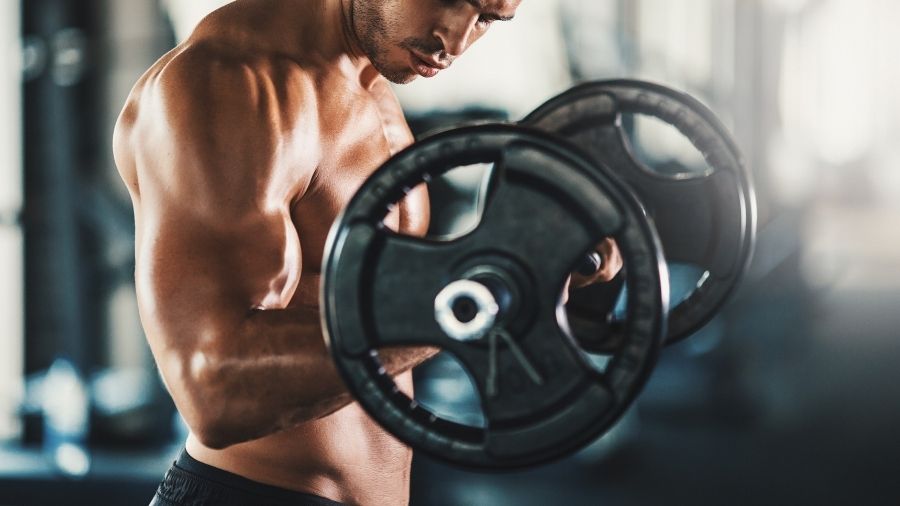
While training to failure isn’t necessary to maximize muscle growth, lifting close to failure on your lighter isolation exercises likely is [4]. Similar results are seen when comparing stopping slightly short of failure to going to failure when it comes to muscle growth.
Heavier compound exercises don't need to be taken near failure to stimulate muscle growth as heavy loads recruit fast-twitch muscle fibers from the first rep. In contrast, lighter isolation exercises don't need to be taken closer to failure to activate those muscle fibers and maximize hypertrophy.
Lift Heavy And Light
The hypertrophy rep range (i.e., 8-12 reps) is an outdated concept. We see similar increases in muscle size regardless of high or low reps as long as the volume load is equated (sets x reps x load). For example, 7 x 3 at 3RM resulted in similar biceps muscle growth to 3 x 10 at 10RM [5].
However, we must take into account a few things:
Lighter loads allow you to get enough training volume without beating yourself up and having to stay in the gym for three hours. That doesn't mean ignoring the lower rep ranges. You can do larger compound movements in the 6-10 rep range and accessory exercises in the 8-20 rep range for various loads.
Bare in mind that you can use loads as low as 30% 1RM and still make significant gains in muscle mass [6]. Further, a variety of rep ranges may even provide a more substantial muscle-building response [6].
Take Advantage Of Progressive Overload
Progressive overload is one of the most critical components of fitness. It relies on the principle of adaptation. Do the same thing enough, and you adapt to the stimulus. For example, ever done an exercise for the first time and woke up the next day, barely being able to move from the soreness?
But the second time you do the exercise, you’re not as sore. And the third, the soreness is gone. This is your body adapting to the stimulus you are placing on it.
Progressive overload is not about making you sore, however. It is about progressively doing more each session, week, or training cycle. Whether that's more weight (intensity), more sets and reps (volume), resting less (density), these are all ways to overload your training progressively.
When it comes to building muscle, volume is what we want to progressively overload and, to some extent, intensity. That means creating a 4–6-week cycle where the number of sets you perform per muscle group per week gradually increases from week to week.
Intensity should also slightly increase at specific points throughout the training cycle to maximize mechanical tension in the muscle, a key mechanism for building muscle [7].
Focus On The Muscles Doing The Work
Bodybuilders, the masters of manipulating body composition, swear by the mind-muscle connection. And while it may sound like broscience, there is scientific evidence to back these claims.
For example, double the muscle thickness of the biceps and quadriceps muscles were found when thinking about squeezing the muscle during the exercises [8].
So, rather than thinking about moving the weight, think about the muscles you are targeting with the exercise to maximize muscle growth.
Sleep And Nap
Recovery is just as important as training. If you are not sleeping enough, your workout quality will suffer, reducing your ability to gain muscle. For example, even a single night of 4 hours of sleep compared to complete rest can reduce your neuromuscular performance by 5% [9].
Meaning you may not be lifting the heavyweights like you usually do. For those chronically underslept, averaging less than 8 hours of sleep per night can put you at a 1.7x greater risk of injury than sleeping 8+ hours per night [10].
One way to potentially counteract the effects of poor sleep, or enhance your performance as a good sleeper, is to power nap during the day. A 15-20 minute nap can enhance physical and mental performance and reverse the negative hormonal impact of poor sleep [11].
Use A Full Range Of Motion
Partial range of motion has its place within a training program for building muscle. For example, to extend a set after reaching failure or close to it. However, the bulk of your muscle gain is going to come from exercises performed within a full range of motion.
To maximize tension within the muscle, it needs to be loaded under stretch. A full range allows the muscle to be loaded through the entire stretch, increasing mechanical and time under tension. This will maximize the muscle-building response.
Which Workout Split Should You Use?
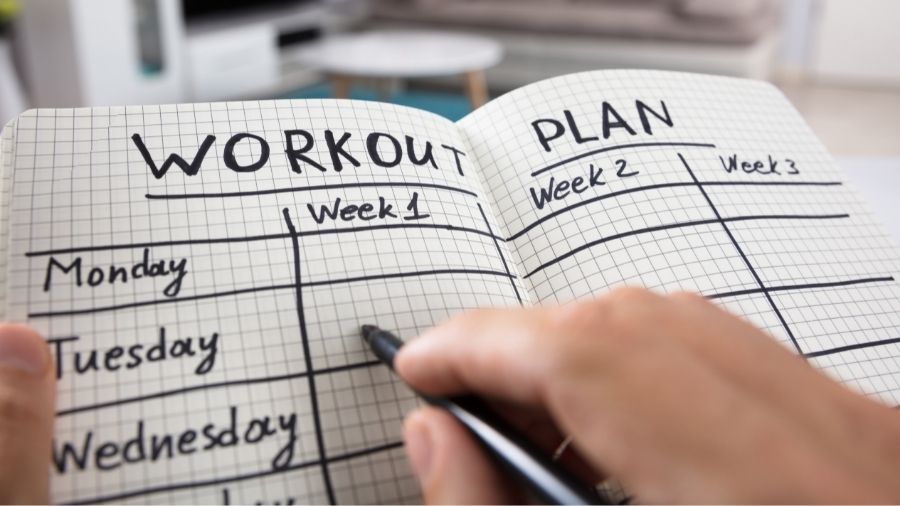
Implementing these eleven tips will turn you from a skinny hard gainer into a muscle-bound monster. But tips will only get you so far. So, let’s talk workout splits. Is one better than the other for gaining muscle mass?
Full-Body Routine
Full-body routines are usually reserved for strength athletes. However, they can be utilized by those who want to build muscle short on time. It allows you to train a muscle group multiple times per week, increasing the quality of your sets. For example, squatting on Monday, leg press on Wednesday, and hack squats on Friday.
All three of these exercises will target the quads, but you are fresh for each exercise instead of performing all three on one day. If you are a beginner to the gym, a full-body routine is the way to go. It allows you to focus on a few main lifts that will make you the most considerable progress and master these exercises.
One disadvantage is that it can be strenuous, pushing close to failure. Because you are training the same muscle groups multiple times a week, muscle soreness and fatigue that lasts more than a day will reduce the quality of your next workout.
Here is a 3- and 4-day weekly structure example of a full-body routine to gain muscle:
3-Day Full Body Weekly Structure
Monday: Full Body Workout A
Tuesday: OFF
Wednesday: Full Body Workout B
Thursday: OFF
Friday: Full Body Workout A
4-Day Full Body Weekly Structure
Monday: Full Body Workout A
Tuesday: OFF
Wednesday: Full Body Workout B
Thursday: OFF
Friday: Full Body Workout A
Saturday: Full Body Workout C
Split Routine
Split routines are usually better when comparing split vs. full-body routines for building muscle. Mainly because you can work out more often, perform more volume per muscle group per week, and create more significant muscular fatigue.
Depending on your split routine, you will work out 4, 5, or even 6 times per week to maximize hypertrophy. Because a split routine splits each workout into upper, lower, or muscle groups, you have plenty of time to recover before training that muscle group again.
Maximizing mechanical tension (lifting heavy or close to failure) and metabolic stress (the 'burn' near the end of a working set) becomes much easier within a split routine. There are many options you can take when designing a split routine. A push-pull legs routine is an excellent option if you have the time. Here are some examples:
4-Day Upper/Lower Split Schedule
Monday: Upper Body Workout A
Tuesday: Lower Body Workout A
Wednesday: OFF
Thursday: Upper Body Workout B
Friday: Lower Body Workout B
5-Day Bro Split
Monday: Chest and Triceps
Tuesday: Back and Biceps
Wednesday: Shoulders and Abs
Thursday: Legs
Friday: Arms (Or whatever body part you want to emphasize)
6-Day Push Pull Legs
Monday: Push Workout A
Tuesday: Pull Workout A
Wednesday: Legs Workout A
Thursday: Push Workout B
Friday: Pull Workout B
Saturday: Legs Workout B
How To Design Your Program
Once you’ve chosen your workout split, you need to design a training program. There are multiple things to consider within each workout:
I will break down each topic to give you the greatest understanding.
Exercise Order & Selection
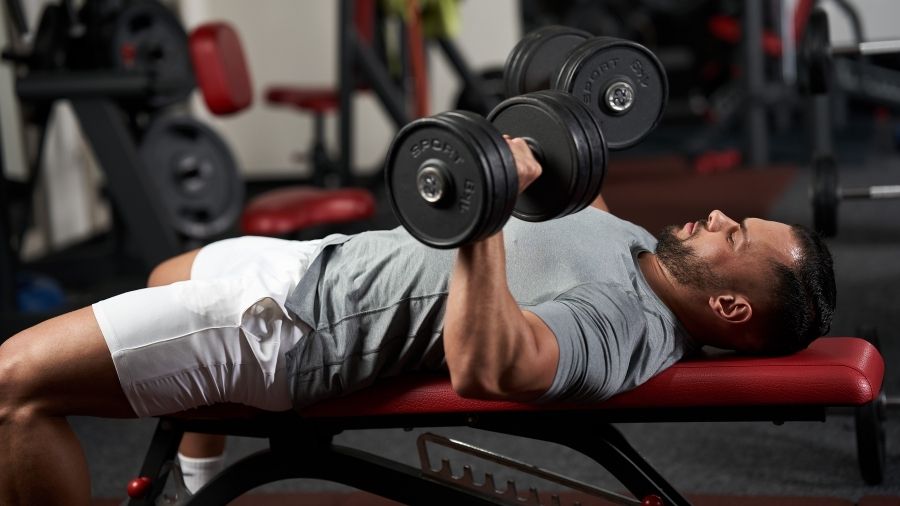
One principle to maintain when organizing your workout is starting with compound exercises before isolation exercises. There are some instances where you may break this principle which I will get to shortly.
An example of performing compound exercises first would be doing the bench press and incline dumbbell bench press before any chest fly or triceps exercise.
This way, you can maximize the load used on exercises that tax all of the muscles you are training that workout before finishing them off through more straightforward isolation exercises. One instance where you may perform an isolation exercise first would be using the leg curl before squats. Try it. Your knees will thank me later.
The same can be said for straight arm lat pulldowns before deadlifts to get the feeling of tightness in the lats that you need when deadlifting.
Regarding exercise selection, this will be completely individual. Some exercises will be out of your reach if you have previous injuries or mobility restrictions. Further, if you work out at home, you will have equipment limitations.
Here are some exercise substitutions for common gym exercises for those who don’t have the equipment:
How Many Sets & Reps?
Once you’ve selected your exercises and placed them in order, you need to assign them sets and reps. The general rule of thumb is compound exercises use lower reps, while isolation exercises use higher reps.
For compound exercises, stick to 6-10 reps per set and for isolation exercises, stick to 10-20 reps per set. This will provide you with an easy framework to follow. Regarding the number of sets per exercise, stick between 2-5 sets. In the beginning, aim for 7-10 sets per muscle group per week.
Here is an example of how this may look for a chest and triceps workout:
A1) Bench press 3 x 8
B1) Incline dumbbell bench press 3 x 10
C1) Dumbbell chest fly 2 x 15
D1) Push-up 2 x 20
E1) Cable triceps extension 4 x 15
F1) Skullcrushers 3 x 12
After a few weeks, you can increase the training volume by adding more sets. Eventually, you want to perform a training cycle of up to 20-25 sets per muscle group per week before reducing the number of sets to 7-10.
Here is a quick summary of how many sets and reps you should do:
Read more: How Many Sets And Reps Should You Do?
How Long Should You Rest Between Sets?
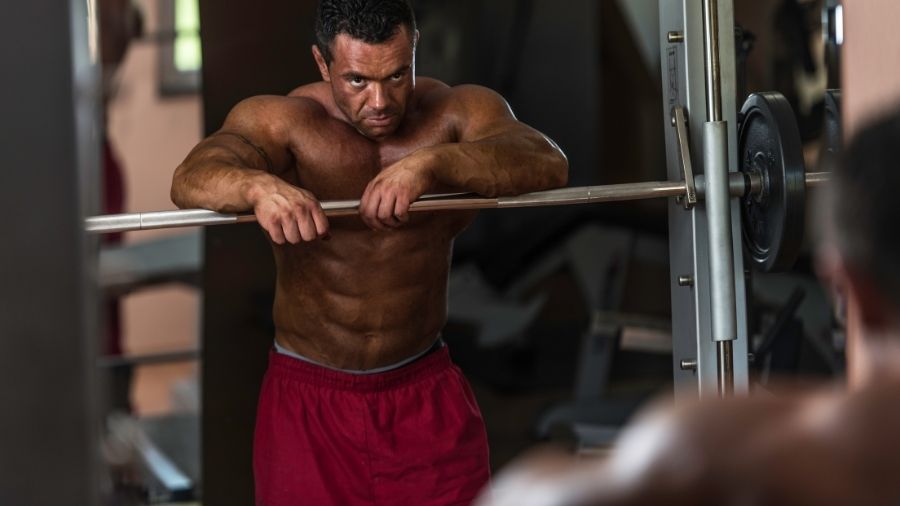
It is commonly believed that you should rest less between sets when trying to build muscle. But this couldn’t be further from the truth. How long you rest between sets will dictate the quality of your workout.
When referencing training volume, we are talking sets x reps x weight. Resting longer means using the same weight for all sets and reps. Shorter rest periods either reduce reps or weight, decreasing overall training volume.
But this is not a blanket rule for all exercises. With easier isolation exercises, such as bicep curls, you may only need 2 minutes of rest to maintain a high training volume [14].
Read more: How Long Should You Rest Between Sets?
How Heavy Should You Lift?
The loads you lift will be dictated by the number of reps you perform. For example, the weight will be heavier when doing sets of 8 squats than sets of 15. But how do you know how heavy to lift once you've prescribed the number of reps?
One way is to use a percentage of your one-rep max (1RM). If you know how much weight you can lift for an exercise for one rep, you can prescribe load based on percentages of that. For example, if you can squat 100 kg (or pounds), 70% of this is 70 kg.
You would then use 70 kg for your working sets. But how do you know which percentage to use? Have a look at the table below:
Percentage | Max Reps |
|---|---|
100% | 1 |
95% | 2 |
90% | 3 |
85% | 5 |
80% | 8 |
75% | 10 |
70% | 12 |
If you have prescribed yourself 8 reps, this is equal to 80% of your 1RM. We want to shoot for anywhere between 1-4 reps shy of failure. Since 80% 1RM would be failure, we want to use anywhere between 78-70% 1RM for the working sets.
Many exercises, however, won't have a 1RM value. For example, dumbbell exercises and other isolation and machine exercises. So, what do you do in this situation? You can work off a rate of perceived exertion (RPE) or reps in reserve (RIR).
These are the same thing but in reverse. RPE is used on a scale of 1-10. RIR is a scale of 10-1. For example, we can prescribe 8 reps with 3 RIR. Meaning we want to select a weight that we can perform 8 reps with but still be able to do 3 more. This would correspond to 7 RPE. Here is a simple illustration:
To prescribe an intensity (or percentage of weight lifted), you can use RIR or RPE instead of knowing your maximum lifts.
How Often Should You Workout?
It may seem that working out more often will lead to more muscle growth. However, this doesn't seem to be the case as long as the volume is equated [15]. For example, if you're performing 10 sets of quadriceps exercises spread over 4 days per week, performing 10 sets over 2 days would not reduce the muscle-building potential.
However, workout frequency has the advantage of increasing training volume with ease. For example, if you aim for 20 total sets for a muscle group, doing so in one workout would be brutal. Not to mention potentially counterproductive.
Spreading those sets over 2 or 3 days will increase the quality of your working sets, allowing you to perform more total training volume. Overall, pick the number of days per week of training based on your life schedule.
Read more: How Often Should You Work Out To Build Muscle?
Intensity Techniques
Intensity techniques are minor changes to exercises or sets and reps that make an exercise harder. These can be periodized within your program based on your training cycle. For example, you may have a 4-week training cycle with no intensity techniques. Then the next 4-week cycle incorporates drop sets.
Because these techniques increase the intensity of the exercise, you don’t want to use these all year round. So, let’s break them down and how you can implement them.
Cluster Sets
Cluster sets are typically reserved for those enhancing strength and power and are simply sets with inter-repetition rest. For example, 3 x 2+2+2 with 30-sec rest would mean you perform 2 reps then rack the bar. Rest 30 seconds, then repeat two more times, making up one set.
One specific cluster set protocol has been shown to build similar muscle mass to traditional sets and enhance 1RM and lower body power [16]. That is 8 x 5 at 65-75% 1RM with 60-second rest between sets. While this strays from a traditional cluster set configuration, it's an excellent protocol to implement for a training cycle.
Read more: Cluster Sets: Your Secret Weapon For Size & Strength
Drop Sets

The drop set is likely one of the first intensity techniques you've tried in the gym. Who doesn't love a viscous pump? They fall under the category or set extenders that allow you to perform more volume and increase the build-up of metabolites.
These metabolites are the by-products of anaerobic energy production (the primary energy system used when lifting weights) that build up within the muscle. It is associated with the burning feeling you get near the end of a set and is one crucial factor for building muscle.
Drop sets can be programmed as double or triple drop sets and will look like this:
Double drop set: 10+10+10
Triple drop set: 10+10+10+10
This simply means reducing the weight after completing 10 reps and repeating with no rest. For example, 90 lbs x 10, 75 lbs x 10, 55 lbs x 10, 40 lbs x 10.
These are brutal and should only be used with isolation exercises like leg extensions and bicep curls. Doing a drop set with the back squat will end your workout right there and then from fatigue.
Read more: Drop Sets vs. Supersets
Supersets
Supersets work by increasing the density of your workout. I.e., performing more work in the same amount of time. A superset is simply performing two exercises back-to-back without rest for the uninitiated. Only after the second exercise do you rest, resulting in the completion of one set.
Typically, a superset is performed with antagonistic pairing, which means opposite muscle groups. For example, a bench press and a barbell row work the chest and back. However, one way to use a superset for building more muscle is to perform both exercises targeting the same muscle group.
For example, push-ups superset with chest flys, or leg extensions superset with walking lunges. These supersets will take your pain tolerance to the next level and give you an enormous pump.
Isometrics
Using isometrics is another set extending strategy that will force the blood to pool within the muscle. This is why it creates the burn as less oxygen-carrying blood can get into the muscle. For example, you can perform 10-20 push-ups, then hold the bottom position with your chest slightly off the floor for 10-20 seconds.
This is how it would look on a program:
3 x 10 + 10 sec ISO bottom position
So, you’d perform 10 reps of the exercise and then hold the bottom for 10 seconds. This would complete one set.
Read more: Isometrics For Hypertrophy
Partials
If you recall, one of my eleven tips was always to use a full range of motion. I stand by this. But you can use partials to extend a set to perform more volume. You've likely heard or done 21's for your biceps.
This is one example of using partials where you can get more reps with a heavier load where you perform 7 full-range reps, 7 bottom half partials, and 7 top half partials. However, a better example would be performing an isolation exercise to failure or 1 RIR, such as a bicep curl, then performing 8-12 bottom half partials.
It would look like this in your program:
3 x 10 + 8 bottom half partials.
These are best done after your main lifts. For example, you may squat with traditional sets and reps. Then leg press with partial rep set extenders.
Nutrition

Training is your catalyst for building insane amounts of muscle. But without the support of your diet, you aren’t going to grow. That is why the first tip in this article was to eat more. So, let's answer the crucial nutrition questions you may have when building muscle.
How Many Calories To Eat To Gain Muscle?
How many calories you need to eat to gain muscle depends on your makeup and activity level. You can have the same bodyweight as someone else but may need to eat more or less depending on other factors such as how much muscle mass you have and how active you are outside of the gym.
But there are a few straightforward ways to calculate how many calories you need to eat to gain muscle:
How Much Protein Do You Need To Build Muscle?
Protein is the most critical macronutrient for your muscle-building journey and is your muscles' building block. Many people tend to undereat protein, not knowing that the current RDA of 0.8 g per kg of body weight is far below optimal.
While you may have heard that more protein is always better, there is a limit. So no, you don’t need to eat 400 g of protein per day like your favorite bodybuilder. There, I just saved you a few hundred dollars per month.
The standard protein recommendation is 1 g per pound of body weight per day. Or 2.2 g per kilogram of bodyweight. This is seen as the optimal protein intake to maximize strength and hypertrophy [17]. However, some hard gainers may find it challenging to reach these protein requirements or struggle to afford the vast amount of meat.
You can lower your protein intake, in this case, up to 1.6 g per kilogram of body weight or 0.75 g per pound. It turns out excess carbs and fats when bulking are protein sparing, so you'll still maximize increases in muscle mass with less protein [18].
Read more: Protein Absorption Myth
How Much Fat Per Day To Build Muscle?
Diets go in trends. Through the 1980s and 90s, it was all about low fat. Recently, the pendulum has swung the opposite way, and many people are pushing high-fat diets. A lower-fat diet is ideal for someone trying to optimize the muscle-building process.
It allows you to eat more carbohydrates giving you three main benefits:
I prefer setting daily fat intake to 25% of your total calories. If you were eating 3000 calories per day, that would equal 750 calories from fat. Since there are 9 calories per gram of fat, this would equal 83 g of fat per day.
If you prefer eating slightly higher fat, I would cap your fat intake to 30% of your daily calories.
How Many Carbs Do You Need To Build Muscle?
Carbs will make up the rest of your daily calories. High carbs are essential for maximizing muscle growth for the reasons mentioned above. Let’s use an example of a 160 lb hard gainer who needs to eat 3000 calories to gain weight.
Protein = 160 g (640 calories)
Fat = 83 g (750 calories)
Carbs = 402 g (1610 calories)
Old School Muscle Building Shake
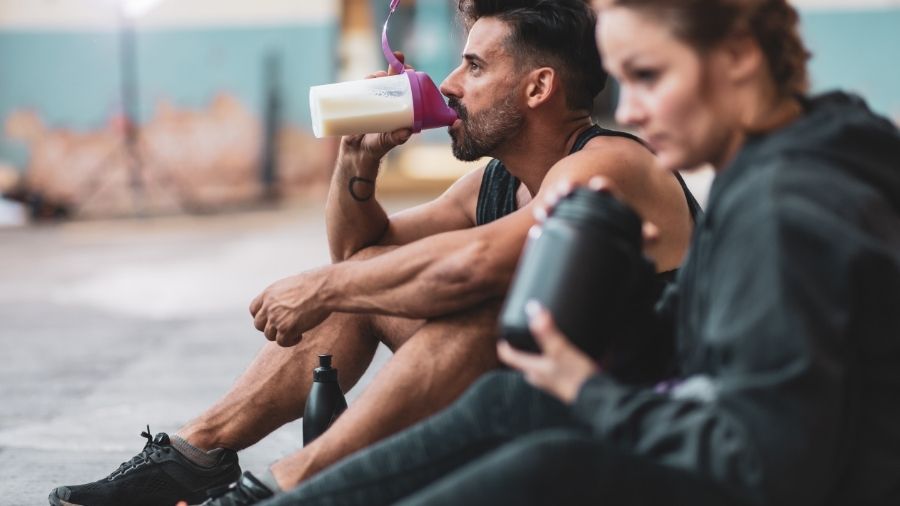
I have a treat for those who don't want to track their calories and are happy to pound food until they can't move. This is an old-time strongman weight-gaining drink that builds muscle and puts hairs on your chest. It is taken from The Development Of Muscular Bulk And Power by Anthony Ditillo.
Have this every other day, and you'll be on your way to building a huge physique.
Best Supplements To Gain Muscle
When looking to gain muscle, the inevitable question arises about supplements. Supplements can help significantly with your muscle-building journey, but you should not rely on them. Sleep, diet, and training are your trifecta.
Supplements can help you with your diet and slightly boost your gains. So, I’ve got a few recommended supplements for building muscle which I will run through below.
Protein Powder
While not completely necessary, protein powder is the most effective supplement as it makes it very easy to reach your protein target and has a relatively cheap cost per serving. Regarding the type of protein, whey is usually the best option as it is cost-effective and has a boatload of evidence supporting its efficacy for building muscle.
However, beef protein is your next best option if you are lactose intolerant or dairy-free. It has been shown to increase muscle mass to the same extent as whey protein over the long term [19]. When you take protein does not matter. Many prefer to take protein powder directly after working out.
A protein shake is a perfect drink if you have a long drive home or can't eat a meal. As long as you hit your protein target each day, don’t worry so much about timing.
Read more: Beef Protein vs. Whey Protein
Creatine Monohydrate
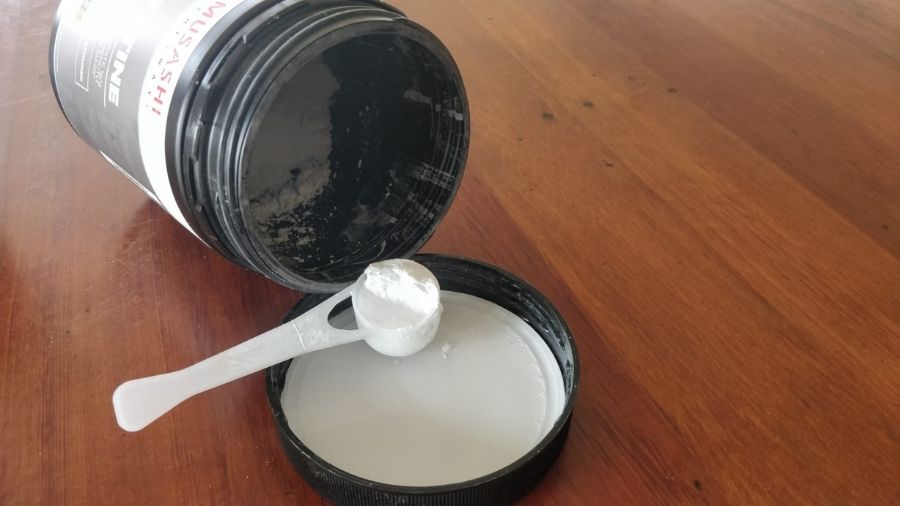
Next on the list is creatine monohydrate. Many myths surround this supplement, yet it is the most studied sports supplement and one of the most effective. Creatine is an instant strength enhancer where research has shown subjects can perform 14% more reps with a given load [20].
How does it work? It enhances your alactic or ATP-CP energy system. To break the science down to the layman, creatine molecules are stored within the muscle and bind to phosphate.
This creates phosphocreatine or PCr. By taking creatine, you can increase your PCr stores within the muscle, which are vital for regenerating energy that the muscles use during exercise. A muscle's energy source comes from adenosine triphosphate (ATP). Triphosphate means three phosphates.
As ATP is used, it loses a phosphate and turns into adenosine diphosphate (ADP), meaning two phosphates. To restore ADP into ATP, it needs another phosphate. Hence, the more PCr you have, the more phosphate molecules you have to restore energy quickly.
Since the ATP-CP energy system lasts up to 10 seconds of maximal intensity, you can extend your ability to exert maximal effort. Creatine also replenishes glycogen (stored sugar from carbohydrates), so you have more energy stores to create more ATP [21].
The easiest way to take creatine is to dose 3-5 g every day whenever you remember. If you have a protein shake, put it in there, so it becomes a habit. You don't need to load, and there is no advantage for timing your creatine before or after your workout [22].
Pre-Workout
Pre-workout is not an essential supplement for building muscle. A simple coffee or no caffeine at all is perfectly fine. However, some lifters may need a “pick me up” for early morning sessions or may just enjoy the feeling of taking pre-workout before training.
When looking for a pre-workout, you need to find an adequately dosed product. The link below will take you to what I recommend. But these are the active ingredients you are looking for:
Ingredients outside of these likely won't give you the effects you are after. You're looking for caffeine to be between 100-300 mg per serving regarding dose. 3-6 mg per kg of body weight is the dose needed for strength improvements [23].
However, higher doses of taurine mean you don't need very high caffeine doses. So if you find a pre-workout with taurine, it's a great way to reduce your caffeine intake while still enhancing your performance [24].
Read more: Best Pre-Workout For Beginners
Mass Gainer
Finally, we have mass gainer. Mass gainer is not necessary, but some lifters may find it easier to chug a shake than eat more food. It's essential to read the label of the mass gainer and not adhere to their serving sizes.
Some mass gainers will give you 1600 calories in one serving! Safe to say, this is not necessary and an easy way to part you with your hard-earned cash. If a serving size is that large, just use ¼ of a serving to get 400 calories.
Even better, find a mass gainer that doesn't have a large serving size. Most will run closer to 500 calories. Even with these, I would advise you to start with half a serving and reassess from there. I have my recommended mass gainers for skinny guys here.
Building Muscle Frequently Asked Questions
Even though I have run through the training and diet side of the muscle-building equation, more questions arise. I will answer these below.
How Long Does It Take To Build Muscle?
Building muscle is a slow process. For complete beginners, you'll see considerable improvements in strength before seeing changes in muscle mass. But after approximately eight weeks, you will start to see gains in muscle mass.
Dr. Eric Helms recommends a 0.5% to 1.5% increase in body weight per month. This will ensure that your weight gain is predominantly muscle mass instead of fat mass, keeping you lean.
How Can You Gain Muscle Fast?
You can’t gain muscle faster than your body allows (unless you take PEDs which I do not recommend). When most people try to gain muscle faster, they overeat on any food imaginable. While this may help you gain weight faster, it does not mean you are gaining muscle faster. Often, these lifters will just end up fat and have not much to show for it when dieting back down.
Is Working Out 30 Minutes A Day Enough To Build Muscle?
Short, abbreviated routines were a large part of how old-time strongmen trained to build insane strength and physiques. 30 minutes is more than enough time to get 3-5 hard sets of squats before finishing with a gut-busting set of walking lunges until fatigued.
The same can be done with the upper body after 3-5 hard sets of bench press and then push-ups to fatigue.
How Do You Know If You Are Gaining Muscle?
Getting body composition scans is expensive and time-consuming. Not to mention you have to find a laboratory that has the costly equipment. The easiest way to do it is to take progress photos. Take them every 1-2 weeks or every month, and you'll see your body transform from photo to photo.
You'll also notice your clothes becoming tighter, and you may grow out of them completely.
Should You Be Sore After Every Workout?
You should not be sore after every workout. In the beginning, you will be sore. Even if you start a new training program, you are likely to be sore when performing foreign exercises. But as you adapt and become accustomed to the exercises and volume of training, your soreness should subside.
That doesn't mean you won't feel muscle fatigue and a little tenderness the next day when you push a workout. Still, you should not be debilitated with pain like you would after your first leg session.
Can You Workout Every Day To Gain Muscle?
You can work out every day to gain muscle by spreading your weekly volume over seven days. However, I would not recommend increasing training frequency does not equal more muscle gain. Take a day or two off to rest. Working out every day makes you likely to push yourself with too much volume, leading to burnout and fatigue.
Final Thoughts
I've given you everything you need to know to build muscle as a skinny hard gainer. The most important aspect of training to gain muscle is to be consistent with your diet and exercise. Working out hard for one week then stopping the following isn't going to change your physique.
Train hard, eat more, and rest like a hibernating bear and you have a recipe for building loads of quality muscle.
References
1. Morton, R. W., Murphy, K. T., McKellar, S. R., Schoenfeld, B. J., Henselmans, M., Helms, E., ... & Phillips, S. M. (2018). A systematic review, meta-analysis and meta-regression of the effect of protein supplementation on resistance training-induced gains in muscle mass and strength in healthy adults. British journal of sports medicine, 52(6), 376-384.
2. Jéquier, E. (1991). Effect of different levels of carbohydrate, fat and protein intake on protein metabolism and thermogenesis. In Protein-Energy Interactions I/D/E/C/G Workshop; October (pp. 21-25).
3. Schoenfeld, B. J., Ogborn, D., & Krieger, J. W. (2017). Dose-response relationship between weekly resistance training volume and increases in muscle mass: A systematic review and meta-analysis. Journal of sports sciences, 35(11), 1073-1082.
4. Schoenfeld, B. J., & Grgic, J. (2019). Does training to failure maximize muscle hypertrophy? Strength & Conditioning Journal, 41(5), 108-113.
5. Schoenfeld, B. J., Ratamess, N. A., Peterson, M. D., Contreras, B., Sonmez, G. T., & Alvar, B. A. (2014). Effects of different volume-equated resistance training loading strategies on muscular adaptations in well-trained men. The Journal of Strength & Conditioning Research, 28(10), 2909-2918.
6. Schoenfeld, B. J., Grgic, J., Van Every, D. W., & Plotkin, D. L. (2021). Loading recommendations for muscle strength, hypertrophy, and local endurance: A re-examination of the repetition continuum. Sports, 9(2), 32.
7. Schoenfeld, B. J. (2010). The mechanisms of muscle hypertrophy and their application to resistance training. The Journal of Strength & Conditioning Research, 24(10), 2857-2872.
8. Schoenfeld, B. J., Vigotsky, A., Contreras, B., Golden, S., Alto, A., Larson, R., … & Paoli, A. (2018). Differential effects of attentional focus strategies during long-term resistance training. European journal of sport science, 18(5), 705-712.
9. Cullen, T., Thomas, G., & Wadley, A. (2020). Sleep deprivation: Cytokine and neuroendocrine effects on perception of effort. Medicine & Science in Sports & Exercise, 52(4), 909-918.
10. Milewski, M. D., Skaggs, D. L., Bishop, G. A., Pace, J. L., Ibrahim, D. A., Wren, T. A., & Barzdukas, A. (2014). Chronic lack of sleep is associated with increased sports injuries in adolescent athletes. Journal of Pediatric Orthopaedics, 34(2), 129-133.
11. Botonis, P. G., Koutouvakis, N., & Toubekis, A. G. (2021). The impact of daytime napping on athletic performance–A narrative review. Scandinavian journal of medicine & science in sports, 31(12), 2164-2177.
12. de Salles, B. F., Simão, R., Miranda, H., Bottaro, M., Fontana, F., & Willardson, J. M. (2010). Strength increases in upper and lower body are larger with longer inter-set rest intervals in trained men. Journal of Science and Medicine in Sport, 13(4), 429-433.
13. Ratamess, N. A., Chiarello, C. M., Sacco, A. J., Hoffman, J. R., Faigenbaum, A. D., Ross, R. E., & Kang, J. (2012). The effects of rest interval length on acute bench press performance: The influence of gender and muscle strength. The Journal of Strength & Conditioning Research, 26(7), 1817-1826.
14. Senna, G. W., Willardson, J. M., Scudese, E., Simão, R., Queiroz, C., Avelar, R., & Dantas, E. H. M. (2016). Effect of different interset rest intervals on performance of single and multijoint exercises with near-maximal loads. The journal of strength & conditioning research, 30(3), 710-716.
15. Schoenfeld, B. J., Grgic, J., & Krieger, J. (2019). How many times per week should a muscle be trained to maximize muscle hypertrophy? A systematic review and meta-analysis of studies examining the effects of resistance training frequency. Journal of sports sciences, 37(11), 1286-1295.
16. Oliver, J. M., Jagim, A. R., Sanchez, A. C., Mardock, M. A., Kelly, K. A., Meredith, H. J., ... & Kreider, R. B. (2013). Greater gains in strength and power with intraset rest intervals in hypertrophic training. The Journal of Strength & Conditioning Research, 27(11), 3116-3131.
17. Morton, R. W., Murphy, K. T., McKellar, S. R., Schoenfeld, B. J., Henselmans, M., Helms, E., ... & Phillips, S. M. (2018). A systematic review, meta-analysis and meta-regression of the effect of protein supplementation on resistance training-induced gains in muscle mass and strength in healthy adults. British journal of sports medicine, 52(6), 376-384.
18. Jéquier, E. (1991). Effect of different levels of carbohydrate, fat and protein intake on protein metabolism and thermogenesis. In Protein-Energy Interactions I/D/E/C/G Workshop; October (pp. 21-25).
19. Sharp, M. H., Lowery, R. P., Shields, K. A., Lane, J. R., Gray, J. L., Partl, J. M., ... & Wilson, J. M. (2018). The effects of beef, chicken, or whey protein after workout on body composition and muscle performance. The Journal of Strength & Conditioning Research, 32(8), 2233-2242.
20. Rawson, E. S., & Volek, J. S. (2003). Effects of creatine supplementation and resistance training on muscle strength and weightlifting performance. The Journal of Strength & Conditioning Research, 17(4), 822-831.
21. LOON, L. J. V., Murphy, R., Oosterlaar, A. M., Cameron-Smith, D., Hargreaves, M., Wagenmakers, A. J., & Snow, R. (2004). Creatine supplementation increases glycogen storage but not GLUT-4 expression in human skeletal muscle. Clinical Science, 106(1), 99-106.
22. Forbes, S. C., & Candow, D. G. (2018). Timing of creatine supplementation and resistance training: A brief review. Journal of Exercise and Nutrition, 1(5).
23. Astorino, T. A., & Roberson, D. W. (2010). Efficacy of acute caffeine ingestion for short-term high-intensity exercise performance: a systematic review. The Journal of Strength & Conditioning Research, 24(1), 257-265.
24. Souza, D. B., Del Coso, J., Casonatto, J., & Polito, M. D. (2017). Acute effects of caffeine-containing energy drinks on physical performance: a systematic review and meta-analysis. European journal of nutrition, 56(1), 13-27.
